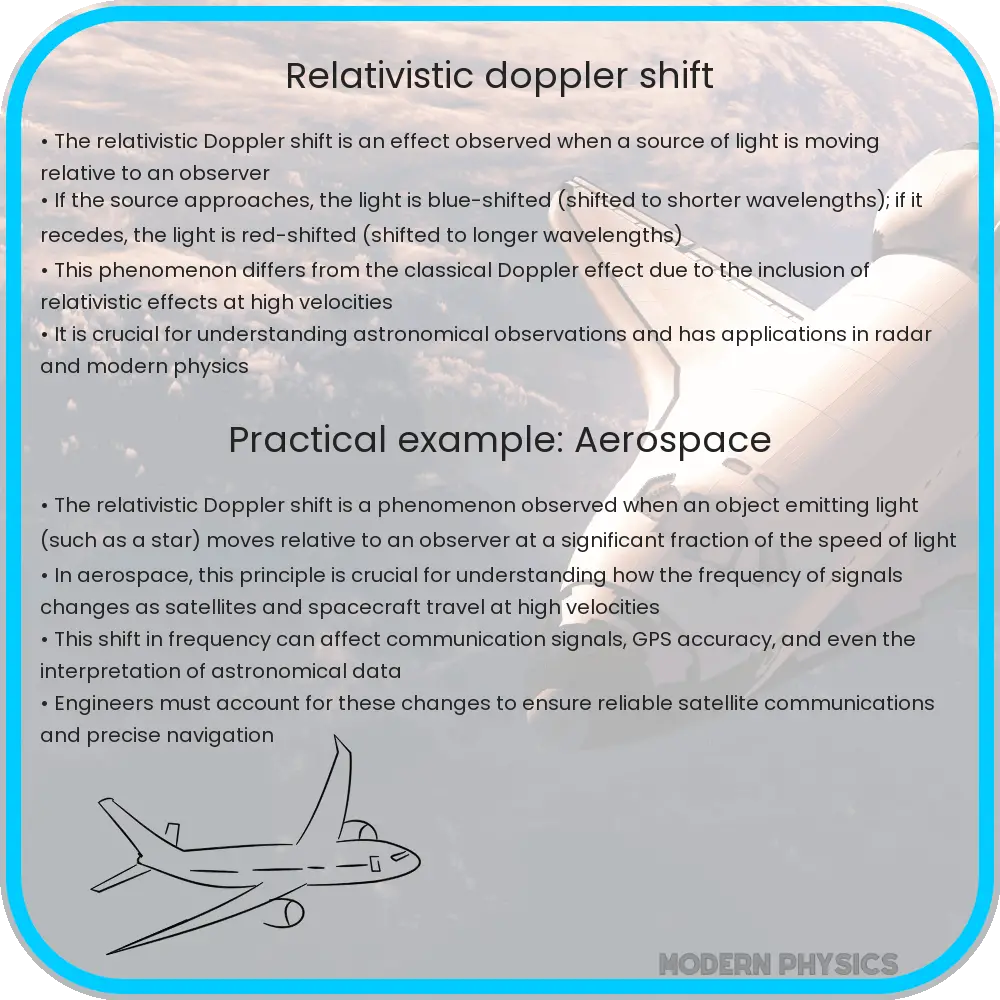Explore the Relativistic Doppler Shift: its impact on astronomy, GPS tech, and testing Einstein’s Theory of Relativity in this in-depth article.

Understanding the Relativistic Doppler Shift
The concept of the Doppler Shift, a phenomenon first described by Christian Doppler in the 19th century, is familiar in everyday life through experiences like the change in pitch of a siren as an ambulance approaches and then recedes. However, when velocities approach the speed of light, this effect becomes significantly more complex, leading to what is known as the Relativistic Doppler Shift. This phenomenon is crucial in understanding various aspects of astrophysics, telecommunications, and even Special Relativity as proposed by Albert Einstein.
Basics of the Relativistic Doppler Shift
In essence, the Relativistic Doppler Shift refers to the change in frequency or wavelength of light or other electromagnetic waves due to the relative motion of the source and the observer. Unlike the classical Doppler effect, which deals with sound waves and can be observed at everyday speeds, the relativistic version becomes significant as the velocity of the object emitting or reflecting the waves approaches the speed of light.
The formula for the relativistic Doppler shift is given by:
f' = f \times \sqrt{\frac{1 + \frac{v}{c}}{1 - \frac{v}{c}}}
Where:
f'is the observed frequency.fis the emitted frequency.vis the velocity of the source relative to the observer.cis the speed of light.
Redshift and Blueshift
In this context, two critical phenomena emerge: Redshift and Blueshift. Redshift occurs when the source moves away from the observer, leading to a decrease in frequency or an increase in wavelength. Conversely, Blueshift happens when the source moves towards the observer, resulting in a higher frequency or shorter wavelength. These effects are not merely theoretical but have practical implications in various scientific fields.
Applications in Astronomy
One of the most prominent applications of the Relativistic Doppler Shift is in astronomy. Astronomers use it to determine the movement and speed of stars and galaxies. The redshift of light from distant galaxies is a cornerstone evidence for the expanding universe hypothesis, which is a fundamental aspect of modern cosmology.
Telecommunication and GPS Technology
Another vital application of the Relativistic Doppler Shift lies in the realm of telecommunications, especially in the functionality of Global Positioning System (GPS) technology. Satellites in orbit travel at high speeds and transmit signals at light’s speed, necessitating corrections for the Doppler Shift to ensure accuracy. Without accounting for both the classical and relativistic Doppler effects, GPS devices would experience significant errors, leading to imprecise location data.
Testing Einstein’s Theory of Relativity
The phenomenon also plays a crucial role in testing and confirming aspects of Albert Einstein’s Theory of Special Relativity. The theory predicts how time dilation and length contraction occur at speeds close to the speed of light, both of which are closely related to the Relativistic Doppler Shift. Experiments in particle physics, involving high-speed particles, routinely observe and utilize this shift, providing empirical evidence supporting relativity theories.
Challenges and Future Prospects
Despite its widespread application, accurately measuring and applying the Relativistic Doppler Shift remains a challenge, especially in extreme astrophysical environments like near black holes or neutron stars, where gravitational effects also play a significant role. Future research in these areas not only helps in understanding the universe better but also in refining our theories of physics.
Conclusion
The Relativistic Doppler Shift is more than a mere extension of the classical Doppler effect; it is a fundamental concept that has profound implications across various scientific disciplines. From providing insights into the universe’s expansion to ensuring the precision of GPS technology, this phenomenon has become an indispensable tool in modern science. As we continue to explore the cosmos and refine our technological capabilities, the understanding and application of the Relativistic Doppler Shift will undoubtedly uncover new horizons in both theoretical and applied physics.
Is this conversation helpful so far?
